Commercial Vehicle Intelligent Chassis Industry Report, 2023, released by ResearchInChina, combs through and researches status quo and related product layout of OEMs and suppliers, and predicts future development trends of commercial vehicle intelligent chassis.
China-SAE defines intelligent chassis as a platform that provides bearing for autonomous driving system, cockpit system, and power system, with capabilities of cognition, prediction, control of interaction between wheels and the ground, and management of its own operating state, and specifically a system implementing vehicle intelligent driving tasks. Referring to the Electric Vehicle Intelligent Chassis Technology Roadmap, currently the development of commercial vehicle intelligent chassis in China focuses on four components, namely, brake-by-wire, steer-by-wire, drive-by-wire, and intelligent suspension. In the trend for commercial vehicle electrification, connection and intelligence, intelligent chassis, as a development cornerstone of vehicle intelligence, has become a development priority of the industry.
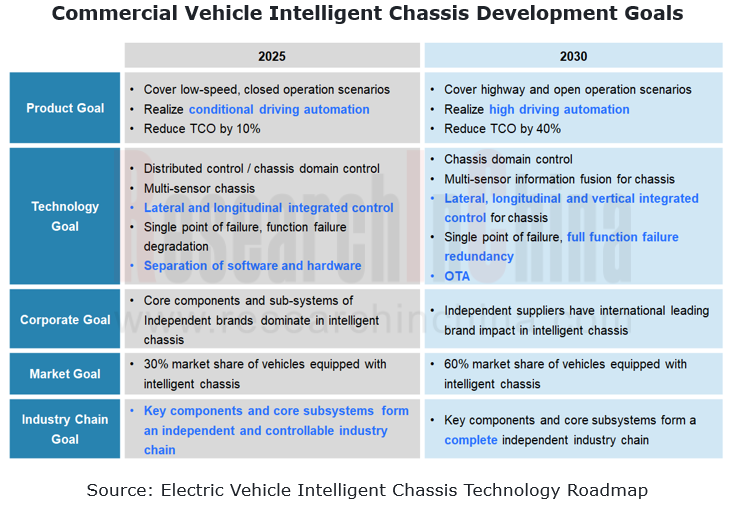
1. OEMs and suppliers accelerate layout of intelligent chassis
Driven by national policies and market demand, OEMs and suppliers have quickened their pace of deploying intelligent chassis to solve the current problem of "insufficiently flexible limbs" in commercial vehicle chassis and support intelligent upgrade of commercial vehicle chassis.
- In 2023, a light commercial vehicle based on skateboard chassis of Farizon Auto (Top 2 in new energy light trucks) will be launched on market in small batches. SuperVAN, Farizon Auto develops using skateboard chassis technology, covers vehicles with gross mass of 2.5 to 5.5 tons, length of 4.5 to 6 meters, and height ranging from flat roof (1.98 meters) and medium roof (2.18 meters, capable of entering underground garages) to high roof (2.5 meters).

- In May 2023, Qingling Motors first introduced its new-generation light electric truck, M600. The commercial vehicle skateboard chassis technology used in the new vehicle integrates three major components of battery, motor, and ECU, as well as drive/steer-by-wire and thermal management in the chassis according to three major domains, bringing much lower redundancy.
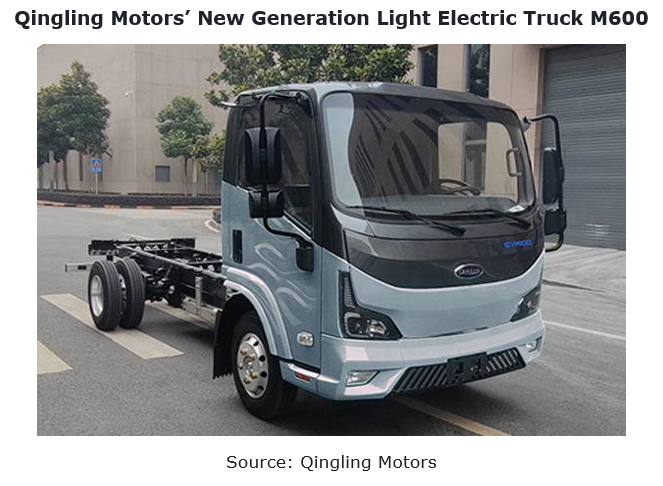
- In March 2023, U POWER released UP Super Board, a skateboard chassis-by-wire which provides support for building small trucks, light buses, vans and light trucks, with length of 4.5-6 meters and load capacity of 2.5-4.5 tons.
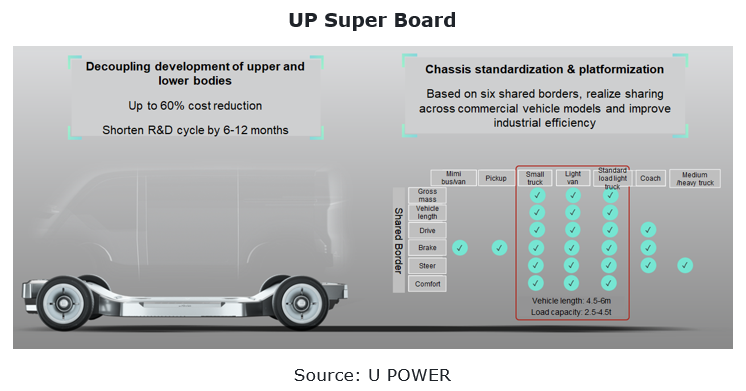
2. Breakthroughs are made in electronic hydraulic brake-by-wire systems for commercial vehicles
Commercial vehicles with large loads have high requirements for braking systems: large braking force, high system reliability requirements, and high control difficulty due to large variation in load. Originally commercial vehicles mainly used air brake systems, but hydraulic brakes find ever broader application in light commercial vehicles, for offering benefits of quick braking response, short braking distance, low cost, a small number of parts, lighter weight, and low maintenance.
Application of brake-by-wire in commercial vehicles started from electronic braking system (EBS). As early as 1996, WABCO's EBS was used in Mercedes-Benz ACTROS series commercial vehicles. In recent years, electronic hydraulic brake-by-wire systems have also been mass-produced and installed in commercial vehicles. In China, typical suppliers are Tongyu Auto, Trinova Auto, and Tsintel Technology.
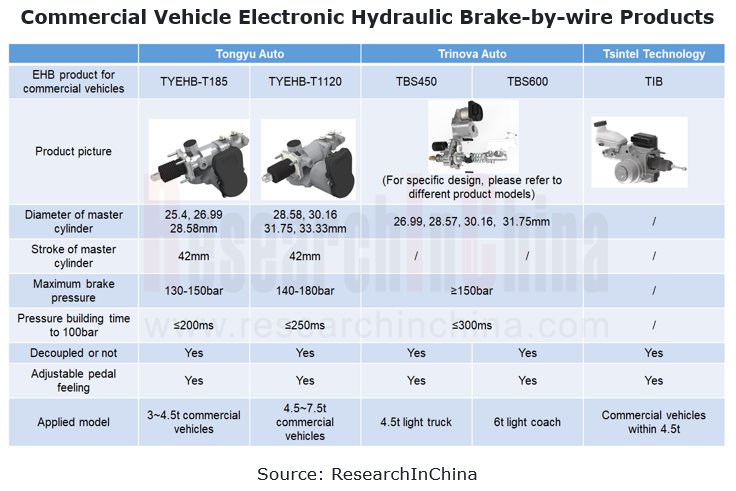
Tongyu Auto is incubated by Tongji University, and its core team has independently developed core chassis-by-wire technologies since 2012. It has gained capital investment from OEMs such as Dongfeng, BAIC, China South Industries Group Corporation (CSGC), and Xiaomi. Among them, Xiaomi has successively participated in its A+ and B funding rounds.
In Tongyu Auto’s commercial vehicle products, large EHB platform products are applicable to 3t to 7.5t mini trucks, mini coaches, pickups, light trucks, light buses and minibuses; combined braking system solutions can also cover vehicles with load capacity of 12t, further meeting the application requirements of medium-sized trucks and coaches. At present, Tongyu Auto's products have supported dozens of Chinese OEMs, such as FAW Jiefang, Dongfeng, JAC, JMC, SANY Heavy Industry, BAIC Foton, Yutong Group, XCMG, and King Long. Tongyu Auto ranks first in the Chinese commercial vehicle brake-by-wire EHB market.
3. Standardized intelligent chassis matches upper bodies of differing loads according to commercial vehicle application scenarios
Standardized intelligent chassis matching intelligent cabins and scenario-based upper bodies at random meets the requirements of different commercial vehicle scenarios.
- Standardized chassis. Meet requirements of large-scale production for product standardization and reduce production cost. Moreover standardized chassis provides technical support for the development of commercial vehicle sharing.
- General cabin. An intelligent cabin can be connected to a variety of standardized intelligent chassis via specific standardized mechanical interfaces, so as to realize plug-and-play.
- Scenario-based upper body. Upper body is customized according to scenarios to differentially meet specialized needs of scenarios and maximize usage efficiency in the scenarios.
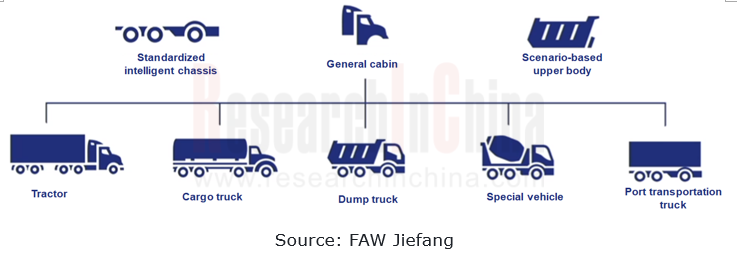
Chassis standardization also facilitates technical development of chassis sub-components. The first is X-by-wire technology. Electronic control replaces mechanical control, completing the process of chassis intelligence 1.0. Once steer-by-wire and brake-by-wire technologies are mature, corner modules may be developed by referring to passenger car chassis to put steering and braking close to wheels. Schaeffler is developing related products. The second is structured battery pack, with battery cells directly integrated into vehicle frame/body to reduce weight and simplify structure. Currently all-electric heavy and light trucks already implement CTP (Cell to PACK) technology, while CTC (Cell to Chassis) technology develops with skateboard chassis as the carrier.
Both OEMs and suppliers now have made layout of standardized intelligent chassis:
- Representative products of OEMs: King Long’s AICO chassis-by-wire, SANY Heavy Industry’s intelligent chassis, Qingling Motors’ all-electric light truck skateboard chassis, Beiben Trucks’ all-electric non-cabin intelligent chassis, etc.
- Representative products of suppliers: Kunlang Technology’s autonomous commercial vehicles, PIX’s skateboard chassis EMC platform, REE’s P7 series chassis, all-electric chassis of Ifyou Technology (a wholly-owned subsidiary of GWM) for new Changzheng No.1 special vehicles, etc.
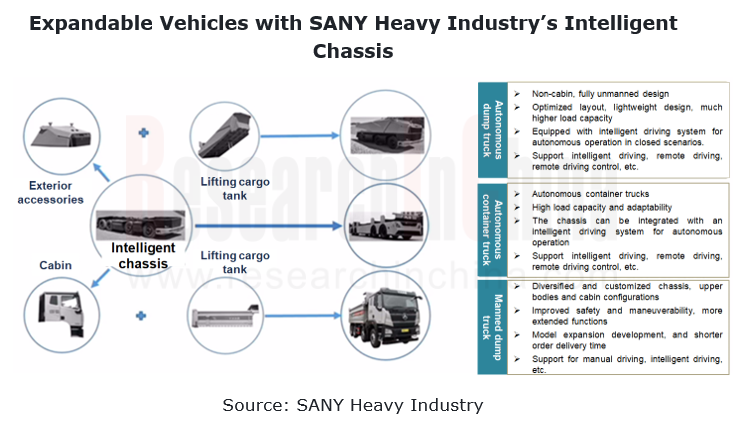
4. Battery-chassis integration reshapes supply relationships
In the wave of commercial vehicle electrification, batteries have become another critical component on chassis. At present all-electric commercial vehicles have been promoting CTP and CTC technology, and power battery core technologies are held by major battery manufacturers which have a bigger say in promoting battery-chassis integration.
In CATL’s case, it set up CATL (Shanghai) Intelligent Technology Co., Ltd., its wholly-owned subsidiary specializing in design, production, sales and service of CIIC (CATL Integrated Intelligent Chassis), and has laid out an integrated intelligent chassis production base construction project in Yichun in January 2023.
Conventional battery manufacturers are transforming into integrated suppliers of batteries and chassis. According to relevant research, in the future more than 70% of profits from new energy commercial vehicles will be taken by battery companies. Battery companies are extending downward to the chassis. Commercial vehicle OEMs need to further consider how to have the initiative in development of new energy technologies in the future.
Automotive 4D Radar Industry Research Report 2025
4D radar research: From "optional" to "essential," 4D radar's share will exceed 50% by 2030.
1. 4D imaging radar has transformed from an "optional" to a "must-have" sensor.
4D radar adds the detecti...
China Automotive Multimodal Interaction Development Research Report, 2025
Research on Automotive Multimodal Interaction: The Interaction Evolution of L1~L4 Cockpits
ResearchInChina has released the "China Automotive Multimodal Interaction Development Research Report, 2025"...
Automotive Vision Industry Report, 2025
Automotive Vision Research: Average Camera Installation per Vehicle Reaches 5.2 Units, and Front-View Tricam Installation Exceeds 1.2 Million Sets.
From January to September 2025, the total installa...
Automotive Infrared Night Vision System Research Report, 2025
Automotive night vision research: The rise of infrared AEB, with automotive infrared night vision experiencing a 384.7% year-on-year increase from January to September.
From January to September 2025...
New Energy Vehicle Cross-Domain (Electric Drive System and Powertrain Domain) Integration Trend Report 2025-2026
Electric Drive and Powertrain Domain Research: New technologies such as three-motor four-wheel drive, drive-brake integration, and corner modules are being rapidly installed in vehicles.
Electric dri...
Analysis on Desay SV and Joyson Electronic's Electrification, Connectivity, Intelligence and Sharing, 2025
Research on Desay SV and Joyson Electronic: Who is the No.1 Intelligent Supplier?
Both Desay SV and Joyson Electronic are leading domestic suppliers in automotive intelligence. "Analysis on Desay SV ...
OEMs and Tier 1 Suppliers' Cost Reduction and Efficiency Enhancement Strategy Analysis Report, 2025
ResearchInChina released the "OEMs and Tier 1 Suppliers' Cost Reduction and Efficiency Enhancement Strategy Analysis Report, 2025", summarizing hundreds of cost reduction strategies to provide referen...
Automotive Fixed Panoramic Sunroof and Smart Roof Research Report, 2025
With the intelligent application of car roofs as the core, this report systematically sorts out a series of new products such as fixed panoramic sunroof/openable sunroof, ceiling screen, roof ambient ...
Automotive-Grade Power Semiconductor and Module (SiC, GaN) Industry Research Report, 2025
SiC/GaN Research: Sales volume of 800V+ architecture-based vehicles will increase more than 10 times, and hybrid carbon (SiC+IGBT) power modules are rapidly being deployed in vehicles.
Sales volume o...
Cockpit Agent Engineering Research Report, 2025
Cockpit Agent Engineering Research: Breakthrough from Digital AI to Physical AI
Cockpit Agent Engineering Research Report, 2025 starts with the status quo of cockpit agents, summarizes the technical ...
Prospective Study on L3 Intelligent Driving Technology of OEMs and Tier 1 Suppliers, 2025
L3 Research: The Window of Opportunity Has Arrived - Eight Trends in L3 Layout of OEMs and Tier 1 Suppliers
Through in-depth research on 15 OEMs (including 8 Chinese and 7 foreign OEMs) and 9 Tier 1 ...
China Commercial Vehicle IoV and Intelligent Cockpit Industry Research Report 2025
Commercial Vehicle IoV and Cockpit Research: The Third Wave of Passenger Car/Commercial Vehicle Technology Integration Arrives, and T-Box Integrates e-Call and 15.6-inch for Vehicles
I. The third wav...
Intelligent Vehicle Electronic and Electrical Architecture (EEA) and Technology Supply Chain Construction Strategy Research Report, 2025
E/E Architecture Research: 24 OEMs Deploy Innovative Products from Platform Architectures to Technical Selling Points
According to statistics from ResearchInChina, 802,000 passenger cars with domain...
Research Report on Intelligent Vehicle Cross-Domain Integration Strategies and Innovative Function Scenarios, 2025
Cross-Domain Integration Strategy Research: Automakers' Competition Extends to Cross-Domain Innovative Function Scenarios such as Cockpit-Driving, Powertrain, and Chassis
Cross-domain integration of ...
China Autonomous Driving Data Closed Loop Research Report, 2025
Data Closed-Loop Research: Synthetic Data Accounts for Over 50%, Full-process Automated Toolchain Gradually Implemented
Key Points:From 2023 to 2025, the proportion of synthetic data increased from 2...
Automotive Glass and Smart Glass Research Report, 2025
Automotive Glass Report: Dimmable Glass Offers Active Mode, Penetration Rate Expected to Reach 10% by 2030
ResearchInChina releases the Automotive Glass and Smart Glass Research Report, 2025. This r...
Passenger Car Brake-by-Wire (BBW) Research Report, 2025
Brake-by-Wire: EHB to Be Installed in 12 Million Vehicles in 2025
1. EHB Have Been Installed in over 10 Million Vehicles, A Figure to Hit 12 Million in 2025.
In 2024, the brake-by-wire, Electro-Hydr...
Autonomous Driving Domain Controller and Central Computing Unit (CCU) Industry Report, 2025
Research on Autonomous Driving Domain Controllers: Monthly Penetration Rate Exceeded 30% for the First Time, and 700T+ Ultrahigh-compute Domain Controller Products Are Rapidly Installed in Vehicles
L...